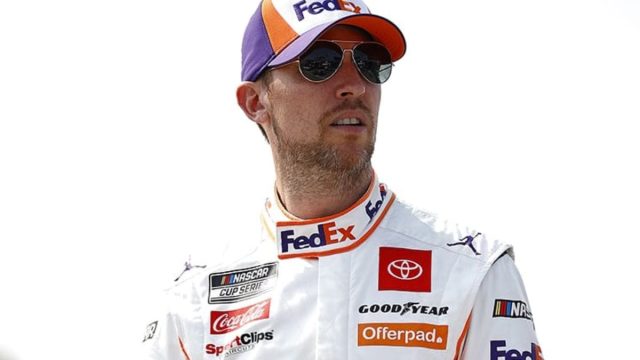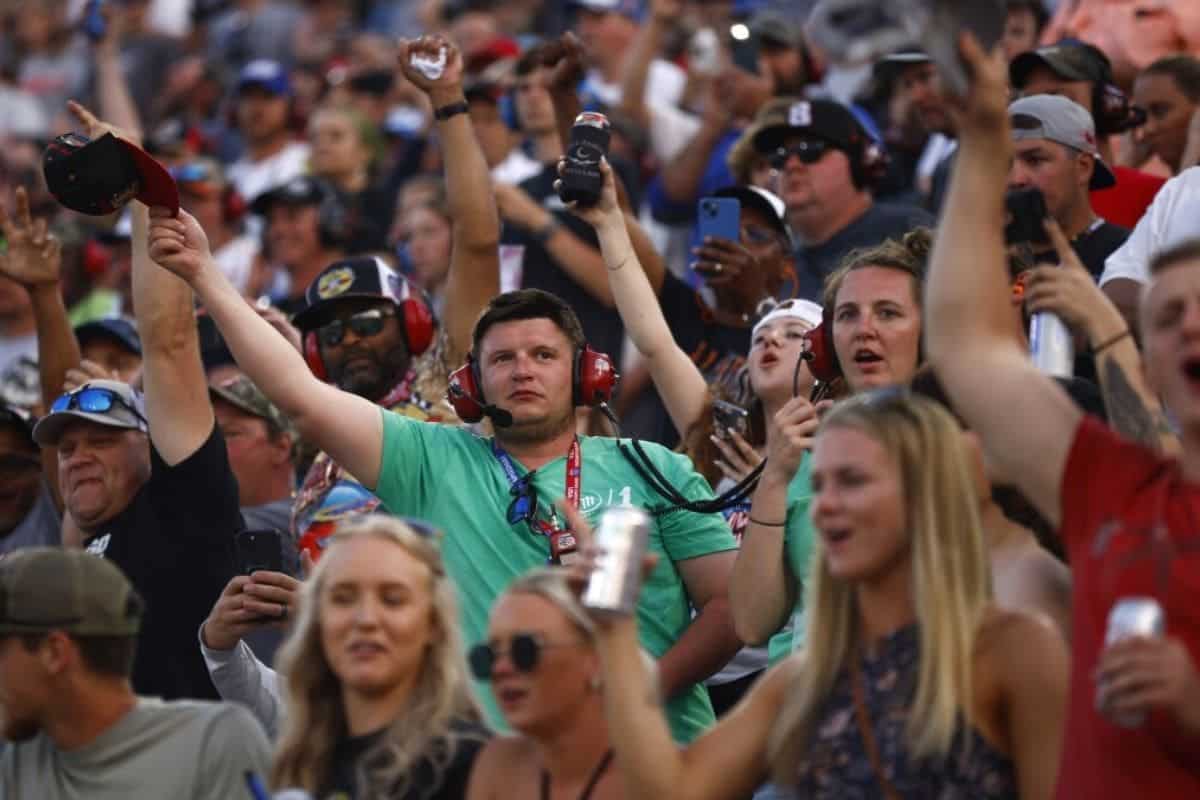NASCAR Fans Rally Behind Hamlin’s Bold Move: NASCAR fans have increasingly rallied behind Denny Hamlin‘s initiative to dismantle the parity craze that has permeated the sport, a move seen as a response to regulations that many argue have diluted the competitive edge and excitement of racing. Hamlin’s public stance against the current rules, which he believes hamper driver skill and race strategy, has struck a chord with a fanbase longing for the days of unpredictable, high-stakes competition. This growing support highlights a broader dissatisfaction within the community and raises pressing questions about the future direction of NASCAR—questions that NASCAR’s leadership can no longer afford to ignore.
Key Highlights
- Denny Hamlin advocates for changes to reduce the standardization of the Next-Gen car, which has sparked significant fan support.
- Fans believe Hamlin’s proposal could restore driver skill as a critical factor in racing success.
- There’s a growing consensus among fans that the current regulations stifle creativity and diminish racing excitement.
- Hamlin’s move highlights the community’s dissatisfaction with the lack of competition and thrill in recent races.
- The NASCAR community feels that addressing these concerns is crucial for the sport’s long-term engagement and financial health.
Controversy Surrounding the Next-Gen Car in NASCAR
The introduction of the Next-Gen car in NASCAR, aimed at leveling the playing field by standardizing components, has sparked significant debate among fans and industry insiders alike. Central to this controversy is the delicate balance between fostering competitiveness and preserving the sport’s inherent excitement. By reducing team-specific adjustments, NASCAR aimed to mitigate the performance gaps between smaller teams and powerhouse outfits. However, the implementation has not been without its critics.
Fans have long cherished the ingenuity and innovation that individual teams bring to the sport. The move towards parity, while theoretically sound, has been perceived by some as diminishing this crucial aspect. Many argue that the standardized approach stifles creativity and reduces the distinctive edge that certain teams traditionally wield. This perceived homogenization of the competition has led to concerns that the racing product lacks the drama and unpredictability that fans crave.
Despite the intent to level the playing field, powerhouse teams continue to dominate the winner’s circle. This highlights a fundamental challenge: while smaller teams have indeed managed to match the top contenders in terms of speed, translating this parity into race victories remains elusive. The prevailing sentiment is that true competitiveness extends beyond mere technical specifications; it encompasses strategy, driver skill, and the subtle interplay of race-day decisions.
As the debate rages on, the Next-Gen car’s impact on the sport’s future remains a contentious topic, with passionate voices on both sides advocating for either a return to tradition or a continued push towards parity.
Challenges on Different Tracks
While the debate regarding the impact of the Next-Gen car on competitiveness continues, its performance on different track types has revealed distinct challenges that further fuel the controversy. Particularly, short tracks and superspeedways have become focal points of critique. These tracks, traditionally celebrated for their intense and unpredictable racing, have seen races devolve into fuel mileage competitions, much to the dismay of loyal fans.
At short tracks, the compact nature and tight turns demand precision and skill, but the Next-Gen car’s design has led to fewer overtaking opportunities, diminishing the on-track action. Superspeedways, known for their drama and drafting battles, have also suffered. The current car’s aerodynamic and mechanical setups often result in processional races where strategy overshadows head-to-head competition.
The contrast between these current challenges and the ingenuity seen in previous NASCAR eras is huge. Teams once thrived on innovation to gain a competitive edge, whereas the standardized Next-Gen car has homogenized performance, affecting the excitement and unpredictability that fans crave. This shift raises significant questions about the car’s design and its broader implications on race dynamics.
Criticism from NASCAR Community and Suggestions for Improvement
Amid growing frustration, NASCAR community members, including notable figures like Denny Hamlin’s crew chief Chris Gabehart, have been vocal about the need for substantial revisions to the Next-Gen car to restore the sport’s competitive edge and excitement. Gabehart has specifically highlighted the car’s design flaws that have made racing less challenging, suggesting that adjustments to the horsepower-to-grip ratio could greatly improve the sport’s appeal.
“What we’ve got to do is make it harder. We simply have a horsepower-to-grip ratio imbalance. We knocked out 100 horsepower. We went to a wider tire, we went to independent rear suspension. We increased grip, decreased horsepower. That’s too easy for you, right? That’s too easy for race teams. Therefore, the physics disadvantage from however you line up on the track, given a scenario, is hard to overcome.” – Gabehart
The current design of the Next-Gen car has been criticized for creating a parity craze, where races are perceived as less engaging due to uniformity among competitors. Gabehart and others in the NASCAR community have advocated for several key changes to address this issue:
- Adjusting the horsepower-to-grip ratio: By increasing horsepower or reducing aero grip, drivers would face more challenges, thereby improving the overall spectacle.
- Reducing aero grip: Less aerodynamic grip would necessitate more driver skill, making races more thrilling and unpredictable.
- Increasing horsepower: Higher horsepower would demand superior driving precision and team strategy, heightening the competitive atmosphere.
- Tailoring track-specific setups: Customizing car setups to specific tracks could diversify race outcomes and strategies, adding layers of complexity for both teams and drivers.
Chris Gabehart tells @KevinHarvick that parity is a great goal but the "problem is physics gets in the way." He has some suggestions for the Next Gen car. #NASCAR pic.twitter.com/5OROsRlir5
— HarvickHappyHour (@HarvickHappyPod) June 27, 2024
Fan Reactions and Community Feedback
Echoing the concerns of industry professionals, NASCAR fans have fervently voiced their dissatisfaction with the current Next-Gen car regulations, calling for a return to more challenging and exhilarating races. The sentiment resonates deeply across social media platforms and fan forums, where discussions on the current state of NASCAR racing are both passionate and widespread.
Many fans feel that the homogenization brought about by the Next-Gen cars has diluted the unique skill sets of drivers, making races less thrilling and more predictable. In particular, fans have rallied around the idea that the Cup Series car should emulate the characteristics of late model stock cars, which are renowned for their demanding nature and the skill they require.
He is basically advocating for either more horsepower or less grip which are both great ideas but I think we also really need to look at the spoiler getting shortened as well (ie decreasing aero grip).”
“I feel like he really nailed it there. Not to mention, it’s pretty clear more HP isn’t happening, so might as well try something else.” – fans reaction
This perspective is not just limited to casual observers; seasoned fans with a keen understanding of the sport’s intricacies are advocating for changes that would restore the element of driver skill as a critical determinant of race outcomes. The community’s feedback is not just a clamor for nostalgia but a well-reasoned argument for enhancing the overall spectacle of NASCAR.
The current regulations, many argue, have created a parity that, while well-intentioned, has inadvertently stifled the competitive edge that once defined the sport. Fans frequently cite the insights of experienced crew chiefs like Gabehart, suggesting that their expertise should guide the formulation of future regulations. The growing consensus within the NASCAR fanbase reflects a desire for races that test the mettle of drivers and provide unpredictable, edge-of-the-seat excitement.
“There’s a reason this guy is a top of line crew chief. These are the people @NASCAR should be listening to. More power, narrow the tire, keep the tire fall off to up the off throttle time, and we’d probably have a hell of a show.” – fans’ reaction
Calls for NASCAR to Address Concerns
NASCAR’s leadership faces increasing demands to revise the Next-Gen car regulations, as fans and industry experts both call for changes that will reinvigorate the sport’s competitive essence. The chorus of voices, led by influential stakeholders such as Gabehart, highlights the urgency for NASCAR to strike a balance between parity and the electrifying, unpredictable racing that has historically defined the sport.
The current Next-Gen car, introduced with the aim of leveling the playing field, has sparked polarizing opinions. Enthusiasts argue that while parity promotes a more inclusive competition, it inadvertently dulls the high-octane action that captivates audiences. In response, the NASCAR community is advocating for a strategic re-evaluation of the regulations.
“NASCAR just needs to listen to guys like Chris”. – fans’ reaction
- Loss of individual team innovation: The standardized nature of the Next-Gen car has limited the creative engineering skills that teams like Hendrick Motorsports and Joe Gibbs Racing have traditionally demonstrated.
- Diminished driver skill impact: The emphasis on parity has, according to critics, reduced the influence of driver skill and strategy, elements that are vital to the sport’s allure.
- Spectator experience: The predictability resulting from overly equalized competition is seen as detracting from the thrilling excitement that keeps fans on the edge of their seats.
- Economic implications: Smaller teams may benefit from parity, but the long-term financial health of NASCAR could suffer if fan engagement wanes due to less exhilarating races.
As NASCAR navigates these complex dynamics, the challenge lies in crafting a regulatory framework that preserves the spirit of innovation and competition while ensuring fairness. The decisive actions taken in response to these calls could shape NASCAR’s trajectory in the coming years, making this a critical moment in the sport’s evolution.
News in Brief: NASCAR Fans Rally Behind Hamlin’s Bold Move
The overwhelming support for Denny Hamlin’s stance against the parity-focused regulations reflects a broader dissatisfaction within the NASCAR community. Fans are advocating for a return to more challenging races that emphasize driver skill and competitive excitement.
This collective demand for reform emphasizes a pressing need for NASCAR to address these concerns, potentially leading to significant changes in the sport’s regulatory framework. The rallying behind Hamlin signifies a crucial moment, highlighting the fans’ influential role in shaping the future of NASCAR.
ALSO READ: Denny Hamlin Reveals Top Wet-Weather Tire Specialists in NASCAR



